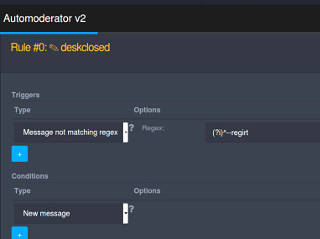
I didn't have the exact reply text as first, so I put a placeholder into the "warn" message. It wasn't really a warning in this case, that's just what the moderation function calls it.
|
As I worked through this I realized that the "answering machine" switch
didn't need to be in-band in the public channel in question.
Rather, it was better to confine that to the *private* IRT and Safety
coordination channel, and dump the results and effect back into the
public channel.
That way, the public would not see the command invocation at all and be
tempted to try it themselves.
Again, a bit of stealth or "authorization" applied to the whole thing, as
only Safety/IRT folks had access to their coordination channel in the
first place.
Note that once the command source channel got moved, the regular-expression parse on the Yag side was semi-redundant because it no longer had to negative-filter any command invocation. But I left that as it was, since it was still a valid trigger for anything else sent in. Grand possibilities open up when one bot is able to affect what another bot does, but we'll see that there are certain limits when describing the "pet quotes" rathole. |